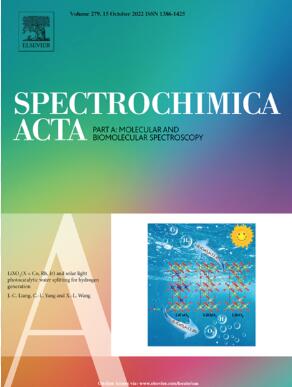Tuning the interparticle distance between assembled copper nanocrystals to improve the optical plasmon resonance, photothermal, and antibacterial properties under visible light
IF 4.6
2区 化学
Q1 SPECTROSCOPY
Spectrochimica Acta Part A: Molecular and Biomolecular Spectroscopy
Pub Date : 2025-07-03
DOI:10.1016/j.saa.2025.126643
引用次数: 0
Abstract
Here, we report the assembly of plasmonic copper nanoparticles capped by poly (vinyl alcohol) via esterification with oxalic acid (OA) as a crosslinking agent. As-synthesized copper nanoparticles measure 8.6 nm and are single crystals, displaying a plasmonic resonance at 392 nm. An increase in the reaction time from 15 to 240 min leads to the assembly of nanoparticles into clusters with decreasing interparticle distances. This is reflected in the appearance of the second plasmon resonance at a longer wavelength, whose intensity and position depend on the reaction time. The influence of the interparticle distance between the assembled copper nanoparticles on the wave propagation of visible light and the optical parameters was studied. The results revealed that decreased interparticle distance between the copper nanocrystals increases the plasmon pulsation frequency and the penetration depth of visible light. This new finding remarkably enhanced the surface plasmon polariton and the surface plasmon resonance along the interface between the dielectric medium and copper nanocrystals. Therefore, the developed nano‑copper assembly with various interparticle distances exhibited outstanding photothermal performance under visible light irradiation for the first time. The study of the antibacterial activity of assembled copper nanoparticles against hospital-associated methicillin-resistant Staphylococcus aureus (HA-MRSA) under visible light irradiation revealed a remarkable efficiency of the nanoparticle sample obtained after 30 min of the reaction with OA and containing medium-size clusters with the interparticle distance of 0.9 nm. This was attributed to an optimal cluster size, allowing easy penetration of the bacterial cell membrane and the comparatively small interparticle distance between copper nanoparticles, leading to strong interparticle interactions and influencing antibacterial activity. This unique feature may open a new avenue for using the proposed synthetic recipe as an alternative for photothermal therapy under visible irradiation instead of laser or UV irradiation with serious harmful effects on living cells.

调整组装铜纳米晶体之间的粒子间距离,以改善光学等离子体共振、光热和可见光下的抗菌性能
在这里,我们报道了用草酸(OA)作为交联剂,通过酯化反应,用聚乙烯醇包覆等离子体铜纳米粒子的组装。合成的铜纳米粒子尺寸为8.6 nm,为单晶,在392 nm处显示出等离子共振。反应时间从15分钟增加到240分钟,导致纳米颗粒聚集成簇,颗粒间距离减小。这反映在较长波长的第二等离子体共振的出现上,其强度和位置取决于反应时间。研究了铜纳米粒子之间的粒子间距对可见光波传播和光学参数的影响。结果表明,随着铜纳米晶体粒子间距离的减小,等离子体激元脉冲频率增加,可见光穿透深度增加。这一新发现显著增强了表面等离子激元极化子和表面等离子激元沿介质与铜纳米晶体界面的共振。因此,所开发的具有不同粒子间距离的纳米铜组件首次在可见光照射下表现出优异的光热性能。在可见光照射下研究组装铜纳米颗粒对医院相关性耐甲氧西林金黄色葡萄球菌(HA-MRSA)的抗菌活性发现,与OA反应30 min后获得的纳米颗粒样品效率显著,颗粒间距离为0.9 nm的中等大小簇。这归功于最佳的簇大小,使细菌细胞膜易于渗透,并且铜纳米颗粒之间的颗粒间距离相对较小,从而导致颗粒间强烈的相互作用并影响抗菌活性。这一独特的特性可能为利用所提出的合成配方替代对活细胞有严重有害影响的激光或紫外线照射下的光热治疗开辟了新的途径。
本文章由计算机程序翻译,如有差异,请以英文原文为准。
求助全文
约1分钟内获得全文
求助全文
来源期刊
CiteScore
8.40
自引率
11.40%
发文量
1364
审稿时长
40 days
期刊介绍:
Spectrochimica Acta, Part A: Molecular and Biomolecular Spectroscopy (SAA) is an interdisciplinary journal which spans from basic to applied aspects of optical spectroscopy in chemistry, medicine, biology, and materials science.
The journal publishes original scientific papers that feature high-quality spectroscopic data and analysis. From the broad range of optical spectroscopies, the emphasis is on electronic, vibrational or rotational spectra of molecules, rather than on spectroscopy based on magnetic moments.
Criteria for publication in SAA are novelty, uniqueness, and outstanding quality. Routine applications of spectroscopic techniques and computational methods are not appropriate.
Topics of particular interest of Spectrochimica Acta Part A include, but are not limited to:
Spectroscopy and dynamics of bioanalytical, biomedical, environmental, and atmospheric sciences,
Novel experimental techniques or instrumentation for molecular spectroscopy,
Novel theoretical and computational methods,
Novel applications in photochemistry and photobiology,
Novel interpretational approaches as well as advances in data analysis based on electronic or vibrational spectroscopy.

 求助内容:
求助内容: 应助结果提醒方式:
应助结果提醒方式:


